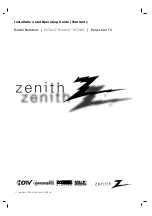
Combined Gas Law
P1V1/T1 = P2V2/T2
General Gas Law or Equation of State of an Ideal Gas
mR= PV/T
The above basic form includes the effect of mass (in pounds).
The right-hand portion of the equation is the same as the
Combined Gas Law. R is a constant that varies with the gas
being considered and the units used. For air in units of the
U.S. system (T in degrees Rankine, V in cubic feet, m in
pounds mass, and P in pounds per square foot absolute-to
obtain psfa, multiply psia by 144), R has the value 53.3.
Variation:
PV = nRT
In this variation, n represents the amount of gas in moles. A
mole is 6.02E+21 molecules; its weight in grams equals the
molecular weight of the gas. This makes R independent of
the gas involved. In metric units (T in degrees Kelvin, V in
liters, and P in atmospheres), R has the value 0.08207.
Flow Measurements -
The volume of air delivered by a
compressor or removed by a vacuum pump is given in cubic
feet per minute (cfm). This may be either cfm at actual
temperature and pressure or standard cubic feet of air per
minute (scfm)-that is, cfm at atmospheric pressure and a
standard temperature of 68 F (20 C). For utmost accuracy,
scfm also requires correction to a standard humidity of 36
percent.) The term "free air" is often used interchangeably
with "standard air." Strictly speaking, "free air" refers to air at
ambient conditions - the conditions at a compressor's intake
or a vacuum pump's discharge port.
1
2
9
Combined Gas Law
P1V1/T1 = P2V2/T2
General Gas Law or Equation of State of an Ideal Gas
mR= PV/T
The above basic form includes the effect of mass (in pounds).
The right-hand portion of the equation is the same as the
Combined Gas Law. R is a constant that varies with the gas
being considered and the units used. For air in units of the
U.S. system (T in degrees Rankine, V in cubic feet, m in
pounds mass, and P in pounds per square foot absolute-to
obtain psfa, multiply psia by 144), R has the value 53.3.
Variation:
PV = nRT
In this variation, n represents the amount of gas in moles. A
mole is 6.02E+21 molecules; its weight in grams equals the
molecular weight of the gas. This makes R independent of
the gas involved. In metric units (T in degrees Kelvin, V in
liters, and P in atmospheres), R has the value 0.08207.
Flow Measurements -
The volume of air delivered by a
compressor or removed by a vacuum pump is given in cubic
feet per minute (cfm). This may be either cfm at actual
temperature and pressure or standard cubic feet of air per
minute (scfm)-that is, cfm at atmospheric pressure and a
standard temperature of 68 F (20 C). For utmost accuracy,
scfm also requires correction to a standard humidity of 36
percent.) The term "free air" is often used interchangeably
with "standard air." Strictly speaking, "free air" refers to air at
ambient conditions - the conditions at a compressor's intake
or a vacuum pump's discharge port.
1
2
9
Combined Gas Law
P1V1/T1 = P2V2/T2
General Gas Law or Equation of State of an Ideal Gas
mR= PV/T
The above basic form includes the effect of mass (in pounds).
The right-hand portion of the equation is the same as the
Combined Gas Law. R is a constant that varies with the gas
being considered and the units used. For air in units of the
U.S. system (T in degrees Rankine, V in cubic feet, m in
pounds mass, and P in pounds per square foot absolute-to
obtain psfa, multiply psia by 144), R has the value 53.3.
Variation:
PV = nRT
In this variation, n represents the amount of gas in moles. A
mole is 6.02E+21 molecules; its weight in grams equals the
molecular weight of the gas. This makes R independent of
the gas involved. In metric units (T in degrees Kelvin, V in
liters, and P in atmospheres), R has the value 0.08207.
Flow Measurements -
The volume of air delivered by a
compressor or removed by a vacuum pump is given in cubic
feet per minute (cfm). This may be either cfm at actual
temperature and pressure or standard cubic feet of air per
minute (scfm)-that is, cfm at atmospheric pressure and a
standard temperature of 68 F (20 C). For utmost accuracy,
scfm also requires correction to a standard humidity of 36
percent.) The term "free air" is often used interchangeably
with "standard air." Strictly speaking, "free air" refers to air at
ambient conditions - the conditions at a compressor's intake
or a vacuum pump's discharge port.
1
2
9
Combined Gas Law
P1V1/T1 = P2V2/T2
General Gas Law or Equation of State of an Ideal Gas
mR= PV/T
The above basic form includes the effect of mass (in pounds).
The right-hand portion of the equation is the same as the
Combined Gas Law. R is a constant that varies with the gas
being considered and the units used. For air in units of the
U.S. system (T in degrees Rankine, V in cubic feet, m in
pounds mass, and P in pounds per square foot absolute-to
obtain psfa, multiply psia by 144), R has the value 53.3.
Variation:
PV = nRT
In this variation, n represents the amount of gas in moles. A
mole is 6.02E+21 molecules; its weight in grams equals the
molecular weight of the gas. This makes R independent of
the gas involved. In metric units (T in degrees Kelvin, V in
liters, and P in atmospheres), R has the value 0.08207.
Flow Measurements -
The volume of air delivered by a
compressor or removed by a vacuum pump is given in cubic
feet per minute (cfm). This may be either cfm at actual
temperature and pressure or standard cubic feet of air per
minute (scfm)-that is, cfm at atmospheric pressure and a
standard temperature of 68 F (20 C). For utmost accuracy,
scfm also requires correction to a standard humidity of 36
percent.) The term "free air" is often used interchangeably
with "standard air." Strictly speaking, "free air" refers to air at
ambient conditions - the conditions at a compressor's intake
or a vacuum pump's discharge port.
1
2
9















































